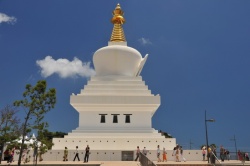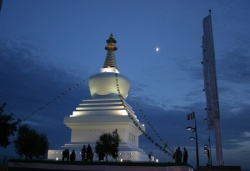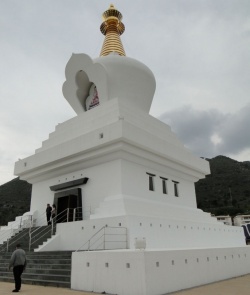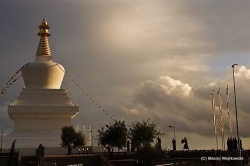Difference between revisions of "Enlightenment Stupa in Benalmádena"
| Line 94: | Line 94: | ||
==References== | ==References== | ||
| − | [ | + | [www.stupabenalmadena.org/en/stupa/introduction/# www.stupabenalmadena.org] |
Revision as of 08:50, 16 January 2013
Welcome to the Enlightenment Stupa in Benalmádena - a vivid monument to the enlightened mind, a Buddhist monument for peace, prosperity, harmony of the world and an ideal place to learn, reflect, and meditate.
The Stupa and its activity are directed and administrated by the cultural association Asociación Cultural Karma Kagyu de Benalmádena and its spiritual guide is H.H. the 17th Gyalwa Karmapa Trinley Thaye Dorje.
It was built due to the inspiration of the great Buddhist Master from Bhutan, Lopon Tsechu Rinpoche, the cooperation of some of his western disciples, and the support of the Local Government of Benalmádena City with its then Mayor, Don Enrique Bolín.
The Enlightenment Stupa was inaugurated on October 5th, 2003. The consecration ceremonies were conducted by the 14th Kunzig Shamar Rinpoche and with the presence of Lama Jigme Rinpoche, the sister of the Queen Mothers of Bhutan, Ashi Sonam Choden Dorji, her husband, Dasho Wangdi Jamyang; Buthan’s Minister Lynpo Sangye Ngodup, Lama Ole Nydahl and his wife Hannah Nydahl and the then Mayor of Benalmádena city, Don Enrique Bolin, as well as with the participation of many distinguished guests and approximately 4000 friends from around the world.
According to the Buddhist teachings there are eight different types of Tibetan Stupas. Each of them represents an important event of the historical Buddha Shakyamuni’s life story. The Enlightenment Stupa (Chang Chub Chorten in Tibetan) symbolizes the achievement of Buddha’s enlightenment, the nature of a fully awakened mind.
Each of the 8 different Stupa types is built according to very precise instructions where both the exact design and proportions have to be correctly followed.
The outer structure of a Stupa has a deep meaning at many levels and its inner treasure chambers are filled with symbolical objects. Consequently qualified Lamas charge the Stupas through powerful ceremonies.
Stupas are normally closed monoliths, which Buddhists circumbulate (by Tibetans referred to by the term kora) while expressing their deep wishes as being in front of Buddha himself. To absorb its beneficial influence into our lives it is recommended to walk around the Stupa in a clock wise direction. Buddhists believe that wishes done near a Stupa may become true.
The Enlightenment Stupa in Benalmádena is one of the few exceptions in the world by having incorporated in its inner structure a meditation hall. This was possible due to the dimensions of the monument - it is until the present day the largest Stupa in the West.
The monument was erected on a panoramic platform overlooking Costa del Sol with the blessing of Lopon Tsechu Rinpoche and with the help of the architect Wojtek Kossowski, who participated in the construction of 18 other Stupas guided spiritualy by the Master.
16 of these Stupas were built in Spain, Germany, Austria, Russia, Switzerland and Poland in the last eleven years of Rinpoche’s life. After his passing away and following his wish, the projects of three more Stupas were accomplished in Denmark, Mexico and Greece.
It is 33 meters (108 feet) tall with a base width of 25.8 meters (82 feet) and contains an over 100 square meter (1100 square-foot) meditation hall inside. From the ceiling of the meditation hall up to its top, the Stupa is completely filled with sacred objects. Its treasure chambers, which are sealed forever, contain among others:
6000 Buddha-reliefs made out of clay by two western disciples of Rinpoche, representing six different Buddhist aspects:
The Historical Buddha Shakyamuni.
Thousand Arm Chenresig - The Thousand Arm Buddha of Loving Eyes.
Sangye Mitukpa.
Sangye Menla - The Medicine Buddha.
Buddha Amytayus - The Long Life Buddha.
Dorje Sempa - The Diamond Mind Buddha.
half a ton of Buddhist prayers printed on cotton paper
the complete teachings of Buddha Shakyamuni - Kanjur (108 volumes) and the complete explanations of the teachings - Tenjur
the Tree of Life - a 17 meter long, especially for that purpose elaborated tree placed vertically in the center of the Stupa, representing the Buddha’s spine, when interpreting the Stupa as Buddha’s body, or representing the Axis Mundi, when interpreting the Stupa as the whole universe
innumerable sacred objects and relicts brought from powerful Buddhist places from the Himalayas
The most precious relict is a Buddha Kashyapa Relict - the previous Buddha before Buddha Shakyamuni’s times
A small Tsa Tsa (clay relief) personally done by the most famous Tibetan Yogi of all times, Milarepa (11th century)
The paintings on the walls of the meditation hall represent the life story of the Historical Buddha Shakyamuni and have been elaborated by Nepalese artists in the traditional religious style of the Himalayas.
An additional space for exhibitions related to Tibetan Buddhism, the Himalayan culture and Stupas around the world, has been adapted underneath the meditation hall.
"We all need a peaceful world. But world peace is not easy to achieve. First one has to practise the Dharma and our mind will become peaceful. As a result everybody will perceive that peace. Just to discuss peace in conferences is not enough. One has to educate and make comprehend that as a starting-point for world peace we need a peaceful mind."
- Lopon Tsechu Rinpoche, Lima 1993
It is perhaps perplexing that the largest Stupa in the western world, and one of the biggest in the world, has been built in Southern Spain in Benalmádena City on Costa del Sol, overlooking the Mediterranean Sea, with breathtaking views of Gibraltar and the African continent.
Buddhism, a philosophy of peace and universal dimension, originated in Asia over 2550 years ago and made inroads into Spain only approximately three decades ago. Along with Buddha’s teachings came its profound symbolism in form of Stupas.
In 1994 a Buddhist master from the Kingdom of Bhutan, Lopon Tsechu Rinpoche, built the first Stupa in Spain at Karma Guen Meditation Center nearby Velez-Malaga, as a landmark of peace and prosperity for the country. That Stupa served as a model for the next 18 Stupas which were built throughout the world in the years to follow under his guidance.
The Enlightenment Stupa in Benalmádena became the last gift of Lopon Tsechu Rinpoche to the West.
It is evident that for the completion of the largest Stupa in this part of the world many causes and conditions had to come together: First of all the warm hospitality and vision of a thriving nation represented by the Local Government Authorities of Benalmádena; further the blessing of a true Meditator of the Himalayas, Lopon Tsechu Rinpoche, and the cooperation of some of his closest western disciples.
In the year 2000, those disciples founded the cultural association ‚Asociación Cultural Karma Kagyu de Benalmádena’ with the purpose of building a Buddhist monument - a Stupa - in Benalmádena Pueblo, and after its completion carrying the responsibility for its maintenance and the spiritual, cultural and educational development around it.
The construction of the Stupa started in the year 2002 and was deeply marked by the passing away of the Master Lopon Tsechu Rinpoche four months before its inauguration.
On October 5th, 2003 the Stupa was officially inaugurated and consecrated by the 14th Kunzig Shamar Rinpoche, the second highest in rank lama of the Karma Kagyu School of Tibetan Buddhism. Since then the Costa del Sol brightens even more.
"An encounter with a Stupa is an encounter with myth – or as Carl Jung and Joseph Campell might have phrased it, an archetypal truth. What may at first seem only to be an artistic and perhaps nostalgic arrangement of brick, stone or wood may eventually come to be seen as an elaborate vessel, transporting the teachings of the Buddha - Buddhadharma - across three millennia."
- Buddhist Stupas in Asia: The Shape of Perfection. 2001
Stupas belong to the oldest architectural forms been built in all countries where Buddhist philosophy flourished: Great India, Ceylon, Central Asia and China, Nepal, Indonesia, Burma, Siam, Cambodia, Laos, Vietnam, Korea, Japan, Tibet, Bhutan.
Their actual shapes and symbolism developed for more than 2550 years from a simple earth reliquary, once built for heroes and kings, to a high complex building expressing a profound knowledge.
Stupas became a multi-purpose symbol, a real treasure of knowledge about outer and inner phenomena, the universe, the nature of our mind and the path leading to the state of full development or enlightenment.
Even though their forms vary depending on the place and time they were built, the Stupas always manifest the victory of the enlightened wisdom over the suffering of ignorance.
At the beginning of the seventies, together with the arrival of Buddhism to the Western World, arrived the understanding about the Stupas’ construction and their deep meaning and symbolism.
Their pure geometrical shapes, their inner filling and their consecration done through rituals performed by high Lamas, grant them a complex symbolism on many levels.
Among others the Stupas symbolise the Buddha himself and his enlightened mind. In the eight different types of Tibetan Stupas are encoded the eight most significant events of Buddha’s life story and His body.
In the subsequent parts of the construction might also be encoded the complete teachings that Buddha Shakyamuni gave (84 000 instructions), as well as our gradual path towards enlightenment.
The shape of the Stupa also symbolizes the elements of which our universe is composed : earth, water, fire, air and conciousness.
Stupas are also mandalas: they manifest pure energy fields of different Buddha emanations. They can also be interpreted as a geometrical diagram of the universe.
Stupas posses a powerful pacifying, protective and enriching effect on their surrounding. They work like energy generators, they grant us blessings.
Seen as helpers on our way of spiritual development they mirror the harmony and perfection of universal principles inherent in our mind and invite us to awaken our full capabilities.
References
[www.stupabenalmadena.org/en/stupa/introduction/# www.stupabenalmadena.org]



